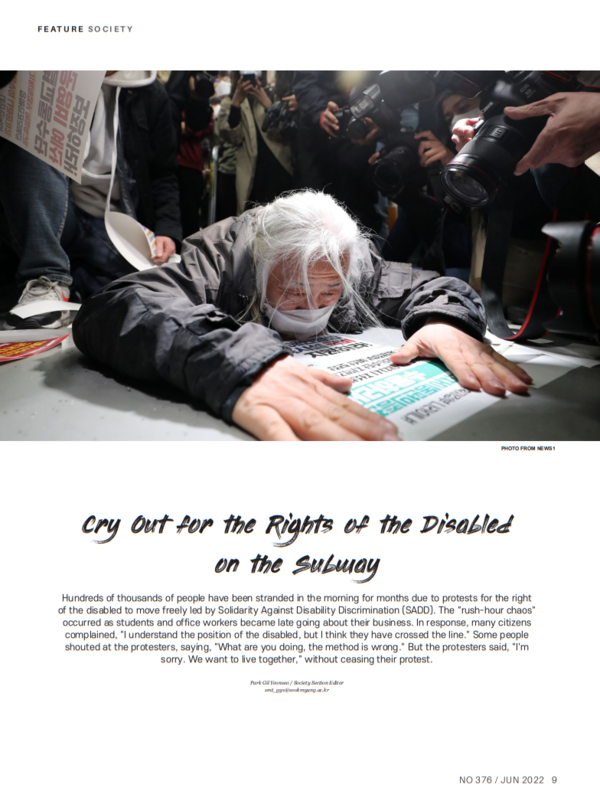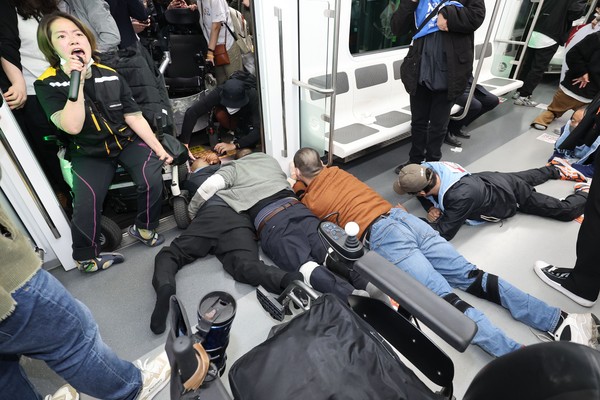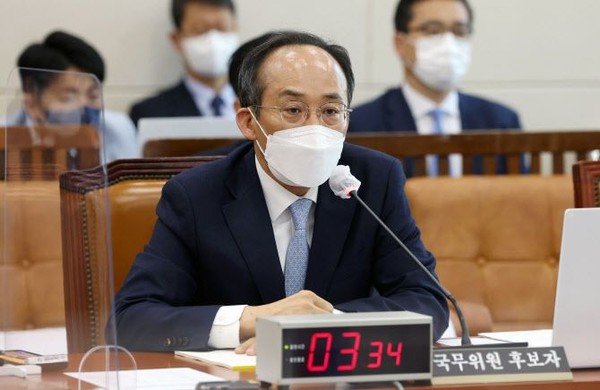
Hundreds of thousands of people have been stranded in the morning for months due to protests for the rights of the disabled to move freely led by Solidarity Against Disability Discrimination(SADD). The "rush hour chaos" occurred as students and office workers became late going about their business. In response, many citizens complained, "I understand the position of the disabled, but I think they have crossed the line." Some people shouted at the protesters, saying, "What are you doing, the method is wrong." But the protesters said, "I'm sorry. We want to live together," without ceasing their protest.
A rush hour subway protest
SADD began protesting to guarantee the rights of the disabled in earnest on December 3 last year. Starting with a protest at Singil Station on Subway Line 1 in July 2018, seven protests were held between January and November last year and are still in progress. There are five major demands:special transportation for the disabled, revision of the Enforcement Decree of the Subsidy Management Act for the Operation of Lifelong Education for the Disabled, full introduction of low-floor buses, reflection of the right to lifelong education for the disabled and support for activities for the severely disabled. SADD held a "getting on the subway on the way to work" protest at City Hall Station on Seoul Subway Line 2 and Gyeongbokgung Station on Line 3. After boarding the train, they protested in a way that prevented the train from leaving, delaying the train service for up to an hour. Subway lines 2 and 3 are the busiest ones during rush hour. According to the Seoul Metro, the average number of daily passengers on lines 2, 3, and 5 during the rush hour from 7 a.m. to 9 a.m. was about 447,000 as of March, accounting for 57.5% of the daily passengers onlines 1 to 8. Earlier, the Seoul Metro stated, "At this time when trains are at maximum use, the delay time that occurs on subsequent trains will increase due to the keeping of essential safety distance between trains," and asked SADD to refrain from protesting. However, SADD continued the protest, and the SADD officials were held at Hyehwa and Namdaemun Police Station on charges of obstructing tram traffic and business. Park Kyungseok, head of SADD, said at the police station on April 25, "The train was delayed in the process of informing citizens of the problem that even the right to move freely is not guaranteed, and this is not a matter of judging whether it is illegal." 1) In this way, he expressed the urgency of guaranteeing the rights of the disabled.
Meanwhile, whether or not these subway protests would resume has depended on the government's response. On May 3, SADD resumed the protest after 11 days. However, the format was changed to the method of crawling on the floor, boarding the subway, and appealing to those around. As aresult, the subway service was delayed for about 10 minutes, and there was a physical clash betweenthe Seoul Metro, which tried to run the trains on time, and protestors who tried to secure wheelchair space during the protest. Prior to the protest, they said they would temporarily suspend the protest until there was an answer about the budget for the disabled by Chu Kyungho, the Deputy Prime Minister and Minister of Strategy and Finance. In a confirmation hearing on the National Assembly's Strategy and Finance Committee on May 2, Chu labeled Justice Party lawmaker Jang Hyeyoung's request to designate special transportation costs for the disabled as a subsidy project. In response, SADD held a press conference at Gyeongbokgung Station just before boarding the subway at the protest and pointed out, "Chu's answer was only one of our demands and only a promissory note for special transportation expenses was issued." 2) SADD judged that Chu's response was not clear. Their protests continued afterward. On May 9, a protest and a shaving ceremony were held onsubway line 4 during rush hour, but there was no delay in the train operation on that day. The nextday, on May 10, President Yoon Seokyeol's inauguration day, SADD also staged aprotest on subway line 5.

Digging up the protest
It is not that there has been no institutional improvement to guarantee the right to move freely for the disabled. With the implementation of the Act on the Promotion of Transportation Convenience of Mobility Disadvantaged Persons enacted in 2005, elevators were installed in subway stations and low-floor buses began to be introduced. According to the "First Plan for the Promotion of Transportation Convenience for the Disabled (2007-2011)," which was first established after the enactment, 31.5% of all city buses had to be replaced with low-floor buses by 2011. However, the actual enactment rate was only 12%. As of September 2021, when the "Third Plan for the Promotion of Transportation Convenience for the Disabled (2017-2021)" was completed, it remained at 30.4%. In other words, even the goal of the first plan was not achieved by the time the third national plan was implemented. Kim Yeji of the People Power Party, who is a disabled person and an alumna of SMWU, pointed out that there is a structural problem in the decision-making process of our society that alienates the disabled. No matter how many times she and other disabled lawmakers propose bills, it is difficult to speak out during the debate or budget deliberation process because there areno disabled members of the Land, Infrastructure and Transport Committee, which mainly deals with the free right to move of the disabled. She said, "It seems necessary for the party's leaders to deploy at least one disabled lawmaker so that they can speak up in various committees." Kim also said, "Although I have been in parliament through 113 bills, I have never had as many interviews as recently. The media will report only when inconveniences, deaths and serious injuries occur." 3) She described the SADD protest as a situation created by political circles and the media. Meanwhile, disabled people want the political community to have the "will to improve" more than anything else as a result of these protests. Bae Jaehyun, who suffers from cerebral palsy, said, "I'm tired of lukewarm answers such as 'I'll review it.'" 4) He emphasized that they want the government's active practice, citing the lack of substantial instrumental guarantees for them despite institutional improvements to guarantee mobility for the disabled.
The aftermath of the protests has brought a wide range of opinions. Another group of disabled people who protested criticized SADD, saying that SADD's actions "reduce sympathy for the disabled." About 200 people with disabilities from the Korea Federation of Organizations of the Disabled and the Korea Traffic Disabled Association held a rally at 11 a.m. on April 21 in front of Exit 5 of the National Assembly Station in Yeongdeungpo-gu. Kim Rakhwan, chairman of theKorea Traffic Disabled Association, said, "We do not disagree with SADD's requests. However, it is wrong to claim without consultation with other disabled groups that the installation of subway lifts guarantees all rights for the disabled to move freely." Kwak Jaeryong, head of the Gyeongbuk Metropolitan Mobility Support Center, said, "SADD, which has less than one-hundredth of the 2.5million disabled people, is making the entire disabled community look bad," criticizing SADD's protest. On May 3, Lee Junseok, head of the People Power Party, said on his Facebook page that "They were told not to hold aprotest by putting wheelchairs on the subway. Then they switched to aprotest in a way that puts their bodies in the way of the subway and stops the subway departure, which is an uncivilized way to unconditionally demand more financial support." 5) He used the term "uncivilized" to point to the long-running protests, and asked SADD to "stop the protest method that inconveniently takes a large unspecified number of people hostage." Lee actively criticized SADD. The aforementioned Kim Yeji visited the protest site on March 28 at Gyeongbokgung Station and knelt to apologize on his behalf. She said, "I don't think any of the protesters want to see a mixture of hate and irritation. Nevertheless, someone should acknowledge that they had to do so, listen carefully, and take care of them." Thus, it was stressed that while discomfort caused by the protests may exist, it is necessary to consider the reason and necessity for it.

The current situation in Korea
In the "2020 Survey on Transportation Facilities for the Disabled" released by the Ministry of Land, Infrastructure, and Transport in June last year, the reality is that the disabled are classified astransportation vulnerable. The survey was conducted on transportation, passenger facilities, and pedestrian environments stipulated to install mobile facilities under the Act on the Promotion of Transportation Convenience of Mobility Disadvantaged Persons. According to the survey, the standard compliance installation rate of mobile convenience facilities in nine provinces nationwide was 72.1%. 'The standard compliance installation rate' means the degree to which mobile convenience facilities are appropriately installed in accordance with the Enforcement Decree of theact. In other words, 7 out of 10 transportation facilities in Korea meet the standards, but 3 arelacking. At first glance, these measures seem good, but when going into detail, the situation isdifferent. First, in the case of buses, the standard compliance installation rate is 88.4%, but this isan illusion when looking at city buses, rural buses, village buses, and express and intercity busestogether. This is because 91.7% of city buses completed installation, but only 69% of rural buses, 74% of village buses, and 59.4% of express and intercity buses. In the case of village buses, the installation rate of the accessible mark for persons with disabilities was also found to be 0%. Thismeans that it is almost impossible to find low-floor buses for the disabled on village buses that area popular way to get to subway stations. Express and intercity buses have a 0% standard fit installation rate for seats for the vulnerable. Looking at urban and metropolitan railways, the rate is 86.6%. However, the destination information mark for persons with disabilitiesin vehicles is 55.2% and accessible mark for persons with disabilitiesis 56.7%, and other standards are still insufficient. In addition, a survey of 444 out of 759 passenger facilities nationwide showed that the rate of providing convenient services for the vulnerable was only 42.4%. It seems that the right to movefreely for the disabled is not fully guaranteed.
Alongside Korea's situation concerning the right to freedom of movement for the disabled, there are cases abroad in which it has been evaluated that those rights have been faithfully guaranteed. The United States enacted the Americans with Disabilities Act in 1990. The law guarantees accessibility to public transportation for the disabled and prohibits discrimination against the disabled in all public places, such as requiring the introduction of low-floor buses. The ADA wasthe result of fierce struggles in the 1970s and 1980s, when the movement for mobility rights forthe disabled was in full swing, such as blocking the front of the bus and climbing the stairs of the National Assembly building. Japan began renovating facilities for the transportation vulnerable several years earlier than Korea. Japan's Ministry of Land, Infrastructure, and Transport introduced the so-called Barrier-Free Act in 2000, which was the Act on the Promotion of Facilitation of Public Transportation for the Elderly and Disabled. As a result, elevators and slopes were installed in 624 out of 625 stations in 10 subway operators nationwide, including Tokyo, in 2017. JR, the Japanese equivalent to Korail, and various private railway companies have completed the maintenance of 95% of the stations with more than 3,000 daily users as of 2020. In addition, the national introduction rate of low-floor buses increased from 0% in 2000 to 63.8% in 2020. Moreover, the Japanese government added a clause called "barrier-free of mind" to the 2020 revised Barrier-Free Act. It signifies it is the bond between people that can solve the gap in the system. Experts say the nation's welfare for the disabled lags behind advanced countries. Lee Bongjoo, a professor of the Department of Social Welfare at Seoul National University, once had a foreign professor say to him, "There are few disabled people on the street. Is Korea a country with a low incidence of disabilities?" He stressed that the rate of disability does not vary much from country to country, which means that disabled people in Korea refrain from outside activities because it is uncomfortable to move. 6) Therefore, he suggested that a significant increase in financial support could be one solution, saying the current level of welfare for mobility rights for the disabled should be greatly improved.

Strategy and Finance Minidter Chu Kyungho is responding to lawmakers' questions at a confirmation hearing held on May 2 when he was a candidate.
On the road to better rights
The law stipulates that "the transportation vulnerable has the right to move safely and conveniently using all means of transportation, passenger facilities, and roads used by non-traffic vulnerable people." These provisions of the right to move will only be established in our society as a practical right, not an empty declaration, when guaranteed through the national budget. The new government seems to need to solve various conflicts triggered by the protests and start overhauling the system so that there are no barriers left between disabled and non-disabled people. The 21-year struggle for mobility for disabled people continues today.
1) Hong Gyubin, "'The Subway Protest' The Head of SADD Was Investigated by the Police... "The Original Sinner Is the Government"", Yonhap News Agency, April 25, 2022
2) Kim Soyoung, "SADD Resumes Protest on the Office-going Hour... Subway Line 3 and 4 Will Be Delayed", The Dong-a Ilbo, May 3, 2022
3) Kim Hyein, "Kim Yeji, Who Apologized to SADD, "I Feel Sorry for Him as the Leader of the Party"", Mediaus, March 29, 2022
4) Kim Sungjin, "It's Not a Subway Protest... Passengers Looked At the Wheelchair That Was Missing", Moneytoday, April 30, 2022
5) Kim Minjeong, "Lee Junseok Said "Continues of UncivilizedWays" to SADD Resuming Rush-hourProtests", Edaily, May 3, 2022
6) See Footnote 3


